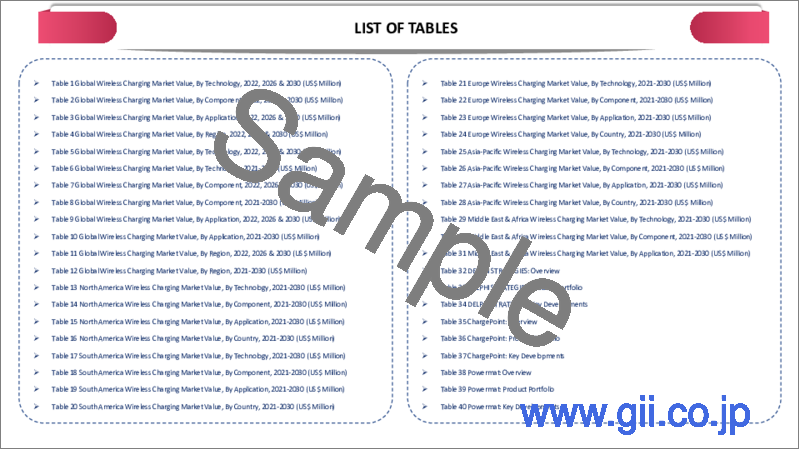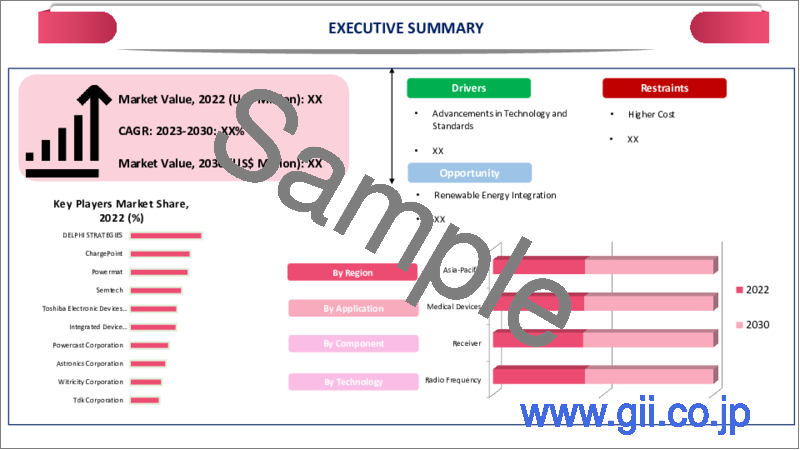|
|
市場調査レポート
商品コード
1268935
ワイヤレス充電の世界市場-2023-2030Global Wireless Charging Market - 2023-2030 |
||||||
|
● お客様のご希望に応じて、既存データの加工や未掲載情報(例:国別セグメント)の追加などの対応が可能です。 詳細はお問い合わせください。 |
|||||||
| ワイヤレス充電の世界市場-2023-2030 |
|
出版日: 2023年05月02日
発行: DataM Intelligence
ページ情報: 英文 193 Pages
納期: 約2営業日
|
- 全表示
- 概要
- 目次
市場概要
世界のワイヤレス充電市場は、予測期間(2023-2030年)に27.3%のCAGRで成長する見通しです。
ワイヤレス充電は、最近、製造業、特にスマートフォン部門から高い関心を集めています。アップルがiPhoneの最新モデルにワイヤレス充電を導入したことで、この技術は一般的に知られるようになり、消費者と企業の両方から期待されるようになりました。技術がこれほどまでに便利になった今、ワイヤレス充電が機器の電源として唯一の選択肢となる日もそう遠くはないと思われます。
市場力学
ワイヤレス充電に対応し、ケーブルなしで充電できるネイティブ機能搭載
今後、市場で販売される携帯電話の多くがワイヤレス充電に対応したり、ケーブルなしで充電できるネイティブ機能を内蔵したりするため、ワイヤレス充電に対する消費者の需要は増加すると予想されます。さらに、公共施設や商業施設でワイヤレス充電が利用できるようになることで、技術的な普及が進むと予想されます。ワイヤレス充電は、ワークスペースをすっきりと整理するための一つの方法です。オープンコンセプトのオフィスの増加により、組織はこれまで以上にQi充電ステーションを必要とするようになりました。ワイヤレス充電技術の多くは広く普及しているため、さまざまな充電器の代わりとなり、スマホ、スマートウォッチ、タブレットなど複数のデバイスで使用することが可能になっています。
特に携帯機器用のワイヤレス充電器の多くは、現段階の技術ではまだ接続が必要です
充電パッドのような周辺機器に電源が接続されている必要があります。ただし、パワーバンクのように誘導充電で充電するものは例外です。しかし、現段階の技術では、コンセントを使うことで自由な行動が制限されるのは事実です。
誘導充電技術は、現在さまざまな規格で実装されています。Open Dots AllianceのOpen Dots規格、Wireless Power Consortiumが作ったQi規格、Alliance for Wireless PowerのRezence規格などがその一例です。
COVID-19の影響分析
COVID-19の分析には、Pre-COVIDシナリオ、COVIDシナリオ、Post-COVIDシナリオがあり、価格ダイナミクス(パンデミック時およびパンデミック後の価格変動とCOVID前のシナリオとの比較)、需要-供給スペクトラム(取引制限、ロックダウンおよびその後の問題による需要と供給のシフト)、政府の取り組み(政府機関による市場、セクター、産業の活性化に関する取り組み)、メーカーの戦略的取り組み(COVID問題を軽減するためのメーカーの取り組み)についても解説する予定です。
目次
第1章 調査手法とスコープ
- 調査手法
- 調査目的および調査範囲について
第2章 定義と概要
第3章 エグゼクティブサマリー
- 技術別スニペット
- コンポーネント別スニペット
- アプリケーション別スニペット
- 地域別スニペット
第4章 市場力学
- 影響要因
- 促進要因
- ワイヤレス充電に対応し、ケーブルなしで充電できるネイティブ機能搭載
- 抑制要因
- 現段階ではまだ接続が必要なものがほとんどである携帯機器用のワイヤレス充電器
- 機会
- 影響度分析
- 促進要因
第5章 産業分析
- ポーターのファイブフォース分析
- サプライチェーン分析
- 価格分析
- 規制分析
第6章 COVID-19の分析
- COVID-19の解析について
- COVID-19シナリオ前
- 現在のCOVID-19シナリオ
- ポストCOVID-19または将来シナリオ
- COVID-19 の中での価格ダイナミクス
- 需給スペクトル
- パンデミック時の市場に関連する政府の取り組み
- メーカーの戦略的な取り組み
- 結論
第7章 テクノロジー別
- 無線周波数
- 誘導性
- レゾナント
第8章 コンポーネント別
- レシーバー
- トランスミッター
第9章 アプリケーション別
- 医療機器
- 自動車
- スマートフォン・タブレット
- ウェアラブルデバイス
- その他
第10章 地域別
- 北米
- 米国
- カナダ
- メキシコ
- 欧州
- ドイツ
- 英国
- フランス
- イタリア
- ロシア
- その他欧州
- 南米
- ブラジル
- アルゼンチン
- その他南米地域
- アジア太平洋地域
- 中国
- インド
- 日本
- オーストラリア
- その他アジア太平洋地域
- 中東・アフリカ地域
第11章 競合情勢について
- 競合シナリオ
- 市況分析・シェア分析
- M&A分析
第12章 企業プロファイル
- Ballard Power System
- 会社概要
- 製品ポートフォリオと説明
- 財務概要
- 主な展開
- Ubeam
- Powermat
- Semtech
- Toshiba Electronic Devices and Storage Corporation
- Integrated Device Technology, Inc.
- Powercast Corp
- Samsung Electronics Co., Ltd.
- Witricity Corporation
- Tdk Corporation
第13章 付録
Market Overview
The global wireless charging market reached US$ XX million in 2022 and is projected to witness lucrative growth by reaching up to US$ XX million by 2030. The market is growing at a CAGR of 27.3% during the forecast period (2023-2030).
Wireless charging has recently attracted much interest from the manufacturing sector, particularly the smartphone sector. With Apple's introduction of wireless charging in its latest iPhone models, the technology is now more generally known and anticipated by both consumers and businesses. With technology becoming so convenient, it won't be long before wireless charging is the sole option for powering devices.
Market Dynamics
Wireless charging compatible and built-in native capabilities for charging without cables
In the coming year, consumer demand for wireless charging is anticipated to increase as more and more phones on the market become wireless charging compatible or have built-in native capabilities for charging without cables. Moreover, the availability of wireless charging in public and commercial settings is expected to increase technological adoption. Wire-free charging is one way to have a neat, organized workspace. Organizations, now more than ever, need to have Qi charging stations due to the rise of open-concept offices. Most wireless charging technologies are widely available, making it possible for them to take the place of many different chargers and be used by several devices, including a phone, smartwatches, and tablets.
Most wireless chargers, particularly those for portable devices, still require a connection at the current stage of technology
A power source must be connected to peripheral equipment like a charging pad. An exception is a power bank supplying a charge using induction charging. However, it is still true that using a power outlet limits one's freedom of movement at the current stage of technology.
Inductive charging technology is currently implemented using a variety of standards. The Open Dots Alliance's Open Dots standard, the Qi standard created by the Wireless Power Consortium, and the Rezence standard from the Alliance for Wireless Power are some of the examples.
COVID-19 Impact Analysis
The COVID-19 analysis includes Pre-COVID Scenario, COVID Scenario and Post-COVID Scenario along with pricing dynamics (including pricing change during and post-pandemic comparing it with pre-COVID scenarios), demand-supply spectrum (shift in demand and supply owing to trading restrictions, lockdown and subsequent issues), government initiatives (initiatives to revive market, sector or industry by government bodies) and manufacturers strategic initiatives (what manufacturers did to mitigate the COVID issues will be covered here).
Segment Analysis
The global wireless charging market is segmented based on technology, component, application and region.
The expansion of infrastructure increased acceptance of wireless devices, higher smartphone penetration, and the Asia-Pacific's size.
In terms of global and local producer numbers and strengths, the global wireless charging market is extremely competitive and fragmented due to the presence of major players such as Qualcomm Technologies, Inc., Ubeam, Powermat, Integrated Device Technology, Inc., Powercast Corp, Samsung Electronics Co., Ltd., Semtech, Toshiba Electronic Devices and Storage Corporation, Witricity Corporation, and Tdk Corporation. Furthermore, major market stakeholders use market strategies such as product launches, mergers, acquisitions, contributions, and collaborations to gain a competitive advantage and recognition in their respective markets.
For instance, the parent firm of Mercedes-Benz, Daimler Inc, announced on November 19, 2021, that it teamed up with Qualcomm Inc to offer wireless charging options for electric automobiles. In a joint statement, Qualcomm and Daimler said that wireless technology would be investigated for use in recharging electric vehicles and enabling plug-in hybrids to operate without ever requiring a plug.
Geographical Analysis
The strong presence of major players, growing industrialization and urbanization, increasing demand for plastic and rubber products, the expansion of infrastructure, increased acceptance of wireless devices, and higher smartphone penetration
The expansion of infrastructure, increased acceptance of wireless devices, higher smartphone penetration, and the region's size as the largest customer base are some of the reasons driving the growth of Asia-Pacific in the global wireless charging market. Moreover, many Asian nations are only beginning to introduce the electric automobile market, which will cause the region to expand tremendously during the projected time.
Competitive Landscape
The major global players in the market Qualcomm Technologies, Inc., Ubeam, Powermat, Integrated Device Technology, Inc., Powercast Corp, Samsung Electronics Co., Ltd., Semtech, Toshiba Electronic Devices and Storage Corporation, Witricity Corporation, and Tdk Corporation.
Why Purchase the Report?
- To visualize the global wireless charging market segmentation by technology, component, application and region commercial assets and players.
- Identify commercial opportunities by analyzing trends and co-development.
- Excel data sheet with numerous data points of wireless charging market-level with all segments.
- PDF report consists of a comprehensive analysis after exhaustive qualitative interviews and an in-depth study.
- Product mapping available as Excel consisting of key products of all the major players.
The global wireless charging market report would provide approximately 61 tables, 58 figures and 193 pages.
Target Audience 2023
- Manufacturers/ Buyers
- Industry Investors/Investment Bankers
- Research Professionals
- Emerging Companies
Table of Contents
1. Methodology and Scope
- 1.1. Research Methodology
- 1.2. Research Objective and Scope of the Report
2. Definition and Overview
3. Executive Summary
- 3.1. Snippet by Technology
- 3.2. Snippet by Component
- 3.3. Snippet by Application
- 3.4. Snippet by Region
4. Dynamics
- 4.1. Impacting Factors
- 4.1.1. Drivers
- 4.1.1.1. Wireless charging compatible and built-in native capabilities for charging without cables
- 4.1.2. Restraints
- 4.1.2.1. Most wireless chargers, particularly those for portable devices, still require a connection at the current stage of technology
- 4.1.3. Opportunity
- 4.1.4. Impact Analysis
- 4.1.1. Drivers
5. Industry Analysis
- 5.1. Porter's Five Forces Analysis
- 5.2. Supply Chain Analysis
- 5.3. Pricing Analysis
- 5.4. Regulatory Analysis
6. COVID-19 Analysis
- 6.1. Analysis of COVID-19
- 6.1.1. Before COVID-19 Scenario
- 6.1.2. Present COVID-19 Scenario
- 6.1.3. Post COVID-19 or Future Scenario
- 6.2. Pricing Dynamics Amid COVID-19
- 6.3. Demand-Supply Spectrum
- 6.4. Government Initiatives Related to the Market During Pandemic
- 6.5. Manufacturers Strategic Initiatives
- 6.6. Conclusion
7. By Technology
- 7.1. Introduction
- 7.1.1. Market Size Analysis and Y-o-Y Growth Analysis (%), By Technology
- 7.1.2. Market Attractiveness Index, By Technology
- 7.2. Radio Frequency*
- 7.2.1. Introduction
- 7.2.2. Market Size Analysis and Y-o-Y Growth Analysis (%)
- 7.3. Inductive
- 7.4. Resonant
8. By Component
- 8.1. Introduction
- 8.1.1. Market Size Analysis and Y-o-Y Growth Analysis (%), By Component
- 8.1.2. Market Attractiveness Index, By Component
- 8.2. Receiver*
- 8.2.1. Introduction
- 8.2.2. Market Size Analysis and Y-o-Y Growth Analysis (%)
- 8.3. Transmitter
9. By Application
- 9.1. Introduction
- 9.1.1. Market Size Analysis and Y-o-Y Growth Analysis (%), By Application
- 9.1.2. Market Attractiveness Index, By Application
- 9.2. Medical Devices*
- 9.2.1. Introduction
- 9.2.2. Market Size Analysis and Y-o-Y Growth Analysis (%)
- 9.3. Automotive
- 9.4. Smartphones and Tablets
- 9.5. Wearable Devices
- 9.6. Others
10. By Region
- 10.1. Introduction
- 10.1.1. Market Size Analysis and Y-o-Y Growth Analysis (%), By Region
- 10.1.2. Market Attractiveness Index, By Region
- 10.2. North America
- 10.2.1. Introduction
- 10.2.2. Key Region-Specific Dynamics
- 10.2.3. Market Size Analysis and Y-o-Y Growth Analysis (%), By Technology
- 10.2.4. Market Size Analysis and Y-o-Y Growth Analysis (%), By Component
- 10.2.5. Market Size Analysis and Y-o-Y Growth Analysis (%), By Application
- 10.2.6. Market Size Analysis and Y-o-Y Growth Analysis (%), By Country
- 10.2.6.1. The U.S.
- 10.2.6.2. Canada
- 10.2.6.3. Mexico
- 10.3. Europe
- 10.3.1. Introduction
- 10.3.2. Key Region-Specific Dynamics
- 10.3.3. Market Size Analysis and Y-o-Y Growth Analysis (%), By Technology
- 10.3.4. Market Size Analysis and Y-o-Y Growth Analysis (%), By Component
- 10.3.5. Market Size Analysis and Y-o-Y Growth Analysis (%), By Application
- 10.3.6. Market Size Analysis and Y-o-Y Growth Analysis (%), By Country
- 10.3.6.1. Germany
- 10.3.6.2. The U.K.
- 10.3.6.3. France
- 10.3.6.4. Italy
- 10.3.6.5. Russia
- 10.3.6.6. Rest of Europe
- 10.4. South America
- 10.4.1. Introduction
- 10.4.2. Key Region-Specific Dynamics
- 10.4.3. Market Size Analysis and Y-o-Y Growth Analysis (%), By Technology
- 10.4.4. Market Size Analysis and Y-o-Y Growth Analysis (%), By Component
- 10.4.5. Market Size Analysis and Y-o-Y Growth Analysis (%), By Application
- 10.4.6. Market Size Analysis and Y-o-Y Growth Analysis (%), By Country
- 10.4.6.1. Brazil
- 10.4.6.2. Argentina
- 10.4.6.3. Rest of South America
- 10.5. Asia-Pacific
- 10.5.1. Introduction
- 10.5.2. Key Region-Specific Dynamics
- 10.5.3. Market Size Analysis and Y-o-Y Growth Analysis (%), By Technology
- 10.5.4. Market Size Analysis and Y-o-Y Growth Analysis (%), By Component
- 10.5.5. Market Size Analysis and Y-o-Y Growth Analysis (%), By Application
- 10.5.6. Market Size Analysis and Y-o-Y Growth Analysis (%), By Country
- 10.5.6.1. China
- 10.5.6.2. India
- 10.5.6.3. Japan
- 10.5.6.4. Australia
- 10.5.6.5. Rest of Asia-Pacific
- 10.6. Middle East and Africa
- 10.6.1. Introduction
- 10.6.2. Key Region-Specific Dynamics
- 10.6.3. Market Size Analysis and Y-o-Y Growth Analysis (%), By Technology
- 10.6.4. Market Size Analysis and Y-o-Y Growth Analysis (%), By Component
- 10.6.5. Market Size Analysis and Y-o-Y Growth Analysis (%), By Application
11. Competitive Landscape
- 11.1. Competitive Scenario
- 11.2. Market Positioning/Share Analysis
- 11.3. Mergers and Acquisitions Analysis
12. Company Profiles
- 12.1. Ballard Power System*
- 12.1.1. Company Overview
- 12.1.2. Product Portfolio and Description
- 12.1.3. Financial Overview
- 12.1.4. Key Developments
- 12.2. Ubeam
- 12.3. Powermat
- 12.4. Semtech
- 12.5. Toshiba Electronic Devices and Storage Corporation
- 12.6. Integrated Device Technology, Inc.
- 12.7. Powercast Corp
- 12.8. Samsung Electronics Co., Ltd.
- 12.9. Witricity Corporation
- 12.10. Tdk Corporation
LIST NOT EXHAUSTIVE
13. Appendix
- 13.1. About Us and Services
- 13.2. Contact Us




